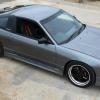Hks Cams Which Ones?
Announcements
-
Similar Content
-
Latest Posts
-
By robbo_rb180 · Posted
I'd be looking at the mentioned EFR kit, room to turn it up if decide on e85 (which we know you will) and be super responsive and fun on the street. OR https://v8roadsters.com/product-category/engine-conversions/engine-conversion-lsx/engine-conversion-lsx-nc/?srsltid=AfmBOorrJa2S76JR5ekXprxBOtU44a1UProbe64YaiVi9zTVp1Lj814w And add whooshy noise for extra fun C5 corvette prices are coming down locally here and a mate has a manual one and is a heap of fun on the street and track. -
By joshuaho96 · Posted
I have an Elite 2500, honestly most of this has been a lot of smaller tasks chasing little details and a whole lot of life getting in the way of bigger projects. I don't mind too much looking at a spectrograph vs having audio knock ears. -
Nah nah nah nah. Don't do it. It's not all about the full throttle power delivery. The main "street fun" and drivability gains from smaller rear (in this case) is how you will have boost available from a low rpm when yo just roll onto the throttle. Think jinking in and out of traffic, coming out of roundabouts, etc etc, where you just want to roll onto the throttle a little and have the spooly noise from ~2000rpm and a swell of torque. More of what you've already achieved by going to 2.5. And then, towards the tail end of 2025 you can pull the turbo 4 out and put in a V8 like we originally suggested. :P
-
Cheers for the info mate, I'm old too, 60 years old next May, so a more linear delivery of the 0.86 would be better as baking tyres and snapping heads isn't on the cards for me or the car I assume a more linear power delivery would be better for engine and drivetrain reliability as well, IRT the torque load at lower RPM???, as well as lower EGT's???, if my understanding of that is correct, have I got that right??? I've only got a really basic understanding of turbo sizing and all there characteristics Cheers for the useful information
-






Recommended Posts
Create an account or sign in to comment
You need to be a member in order to leave a comment
Create an account
Sign up for a new account in our community. It's easy!
Register a new accountSign in
Already have an account? Sign in here.
Sign In Now